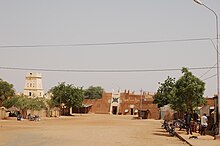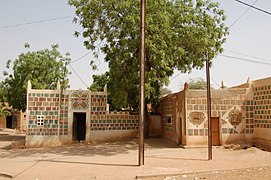Birni (Zinder)
Birni is the historic center of the city of Zinder in Niger .
History and characteristics
Birni was built on large blocks of granite . In 1812, Sélimane dan Tintouma , the first sultan of Zinder, chose Birni as his seat of power. It developed into a settlement of the Kanuri aristocracy. Hausa and Tuareg lived further north in Zengou , the city's second center. The German Africa explorer Heinrich Barth lived in Birni for some time in the mid-19th century. His former house has been preserved.
In 1856, Sultan Ténimoun dan Sélimane Birni protected with a three meter wide and up to seven meter high city wall. The Hausa word birni means "walled city" or "capital". According to legend, Korans and living virgins were walled into the city fortifications to give it a special stability. There were seven city gates assigned different socio-economic, cultural and religious functions: Badaawa in the northeast, Dan Ladi in the northeast, Zongo in the north, Cianciandi in the southwest, Bawréwa in the south, Murya in the southeast and Sankara in the west. In Birni, as in Zengou, an important export-oriented slave market arose .
Sultan Amadou dan Ténimoun was defeated by French troops in the Battle of Tirmini in 1899 and the Sultanate was subjected to France. The French had the city walls of Birni, which had previously been considered impregnable, razed in 1906. Ruins of the adobe walls have been preserved. Zinder became the capital of the French military territory of Niger in 1911 . Until 1926, when the capital was moved back to Niamey , an administrative city with buildings in the French colonial style was built between Zengou and Birni.
The dominant buildings in Birni are the Sultan's Palace of Zinder and the Great Mosque of Zinder . The street network from the 19th century and the traditional Hausa architecture with its richly decorated facades were retained in their basic structure. Many houses were in poor condition and were restored from 2005 as part of a cultural project.
The old town of Zinder, the district Birni and the Sultanate were in 2006 on the tentative list for Niger UNESCO World Heritage added.
Photo gallery
- Traditional architecture in Birni
literature
- Alberto Arecchi, Louis François Delisse: Architettura magica. Le facciate "ricamate" di Zinder, capitale degli Haussa del Niger . Mimesis, Milan 1999, ISBN 88-87231-40-0 .
- Louis François Delisse: Enquête sur l'architecture et la décoration murale à Zinder, effectuée de juin 1970 à décembre 1971 . Center d'études linguistiques et historiques par tradition orale, Niamey 1986.
- Ama Idrissa: Les fonctions de center urbain de Zinder . Thesis. Université scientifique et médicale, Grenoble 1984.
Web links
- La vieille ville de Zinder, quartier de Birni et le Sultanat . UNESCO Center du patrimoine mondial (French).
Individual evidence
- ↑ a b c d La vieille ville de Zinder, quartier de Birni et le Sultanat. UNESCO Center du patrimoine mondial, accessed on February 13, 2018 (French).
- ↑ a b Jolijn Geels: Niger . Bradt, Chalfont St Peter 2006, ISBN 1-84162-152-8 , p. 215 and 217 .
- ↑ a b c d e Jolijn Geels: Niger . Bradt, Chalfont St Peter 2006, ISBN 1-84162-152-8 , p. 221 .
- ^ A b Roberta Ann Dunbar: Slavery and the Evolution of Nineteenth-Century Damagaram (Zinder, Niger) . In: Suzanne Miers, Igor Kopytoff (Ed.): Slavery in Africa. Historical and Anthropological Perspectives . The University of Wisconsin Press, Madison / London 1977, ISBN 0-299-07330-0 , pp. 161 and 175 .
- ↑ Abdourahmane Idrissa, Samuel Decalo: Historical Dictionary of Niger . 4th edition. Scarecrow, Plymouth 2012, ISBN 978-0-8108-6094-0 , pp. 57-58 .
Coordinates: 13 ° 48 ' N , 9 ° 0' E





